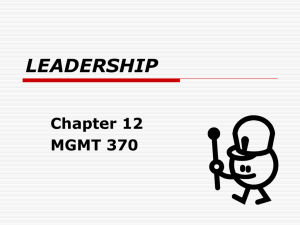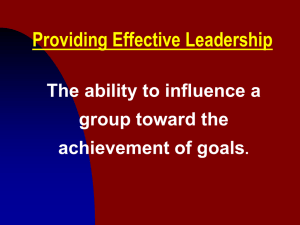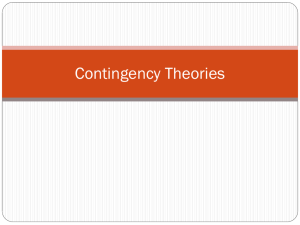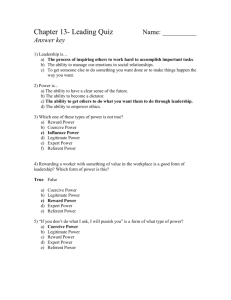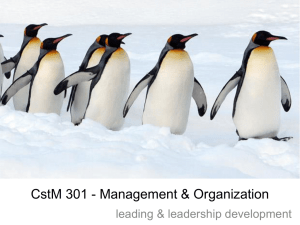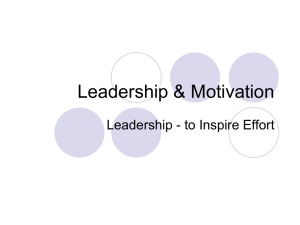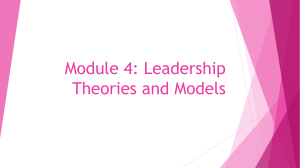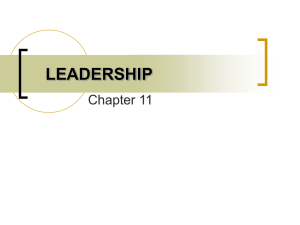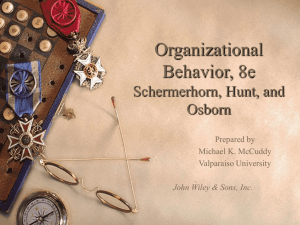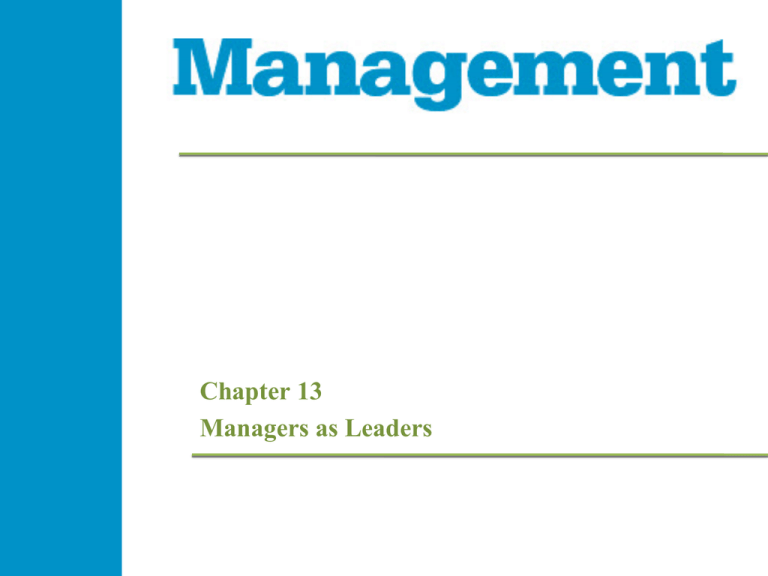
Chapter 13
Managers as Leaders
Learning Objectives
Define leadership in a global context
Explain how managers gain or lose authority
in teams and organizations
Distinguish among four basic types of leaders
Demonstrate the progression of leadership
thought and practice over time
Appraise new and emerging leadership
perspectives
Management 1e
13-- 2
Managers as Leaders (p. 326)
Leadership
• Process of influence aimed at directing behavior toward the
accomplishment of objectives
• Leaders – people who use critical thinking to successfully
influence others to get positive organizational results
through motivation and communication
Leadership in a global economy
• Modality of communication has had a significant impact on
leadership styles and behavior
• Globalized companies affected by external forces that can
significantly change management challenges
Management 1e
13- 3
How Leaders Gain Authority (p. 329)
Power
• Ability to influence
• Leaders may be given power or earn it
• Positional power – influence that is granted
because of a manager’s type and ability to affect
someone positively or negatively through resource
allocation or disciplinary measures
• Personal power – influence that is obtained by
being perceived as likeable and well informed
Management 1e
13- 4
How Leaders Gain Authority (cont.)
Positional power (p. 329)
• Legitimate power – influence that a manager has
because of his or her title inside an organization or
status in a community
• Reward power – influential ability to affect a team
member positively through resources, preferred
schedules, and additional status
• Coercive power – influential ability to influence
people through the threat of or actual negative
consequences for undesired actions
Management 1e
13- 5
How Leaders Gain Authority (cont.)
Personal power (p. 329)
• Referent power – influence that is based on a
manager’s appealing traits or resources, such as
charisma or the ability to offer an employee a
promotion
• Expert power – influence that is derived from
perceived knowledge, skill, or competence
E.g., a manager that is skilled in computer programming
has expert power with a software development team
Management 1e
13- 6
Types of Leaders (p. 330)
Directive leadership
• Involves providing specific, task-focused
directions, giving commands, assigning goals,
close supervision, and constant follow-up
• Influence based on position or legitimate power
Transactional leadership
• Creates reward contingencies and exchange
relationships that result in calculative compliance
on the part of followers
• Provides rewards or punishments for performance
Management 1e
13- 7
Types of Leaders (cont.)
Transformational leadership (p. 330)
• Creating and communicating a higher-level vision in a
charismatic way that elicits an emotional response and
commitment from the followers
Empowering leadership
• Emphasizes employee self-influence processes rather than
hierarchical control processes
• Actively encourages followers to take ownership of their
own behaviors and work processes
• “Leading others to lead themselves”
Management 1e
13- 8
The Evolution of Leadership (p. 332)
Trait perspective
• System of ideas that focuses on identifying
effective leaders through personal characteristics
that are difficult to obtain or cannot be learned
• Great Man Leaders – persons born into positions
of power and authority and seen by some as having
divine right to power (p. 333)
Males were the predominant leaders throughout history
Women are assuming more formal leadership roles
throughout society
Management 1e
13- 9
The Evolution of Leadership (cont.)
Traits of women leaders
Figure 13.1
Management 1e
13- 10
The Evolution of Leadership (cont.)
Major leadership traits
Figure 13.2
Management 1e
13- 11
The Evolution of Leadership (cont.)
Trait perspective (cont.)
• Emotional intelligence (EI) – four major
emotional factors drive leadership performance (p.
333)
Self-awareness
Self-management
Social awareness
Relationship management
Management 1e
13- 12
The Evolution of Leadership (cont.)
Behavioral perspective (p. 334)
• Connects what managers do to their ability to
influence others
• Task behaviors – help team members achieve goals
• Relationship behaviors – enable team members to
be satisfied with one another and their situation
• Ohio State studies
Leader Behavior Description Questionnaire
Consideration – nurture employees
Initiating structure – focused on achieving tasks
Management 1e
13- 13
The Evolution of Leadership (cont.)
Behavioral perspective (cont.)
• Michigan studies (p. 334)
Employee oriented – focus on building interpersonal
relationships
More effective leader behavior
Production oriented – focus on task completion
• Managerial Grid (p. 335) – demonstrates how
managers balance their concerns for results and
people
Plots a leader’s intensity for results and people on 9-point
scales
Defines five major leadership styles
Management 1e
13- 14
The Evolution of Leadership (cont.)
Managerial
Grid
Figure 13.3
Management 1e
13- 15
The Evolution of Leadership (cont.)
Contingency perspective (p. 336)
• Rejects the notion that there is one best way to lead
• Fiedler’s contingency theory – matches the most
suitable leadership style with a particular business
situation
Least preferred coworker scale – defines leadership style
High scorers are relationship motivated
Low scorers are task motivated
Leadership situation defined by:
Leader-member relations
Task structure
Position power
Management 1e
13- 16
The Evolution of Leadership (cont.)
Fiedler’s contingency model
Figure 13.4
Management 1e
13- 17
The Evolution of Leadership (cont.)
Figure 13.5
Management 1e
13- 18
The Evolution of Leadership (cont.)
Contingency perspective (cont.)
• Situational leadership model (p. 338)
Directive behavior – enables the team to achieve goals
through clear directions, planning tasks, organizing and
prioritizing team member actions, and defining a
foreseeable path to success
Supportive behavior – encourages positive
interpersonal relationships and ensures that team
members are comfortable with current circumstances
Employees’ competence and commitment to achieving a
goal determine the appropriate emphasis on directive
and supportive behaviors
Management 1e
13- 19
The Evolution of Leadership (cont.)
Situational
leadership
model
Figure 13.6
Management 1e
13- 20
The Evolution of Leadership (cont.)
Contingency perspective (cont.)
• Path-goal theory – focuses on leadership behaviors that
motivate a team through clarification, support, and removal
of barriers in pursuit of a goal (p. 338)
Four categories of leader behavior
Directive
Supportive
Participative
Achievement oriented
Team member characteristics determine how leader is perceived by
the team
Need for affiliation
Preference for structure
Desire for control
Self-perceived level of ability
Task characteristics also influence the team’s motivation
Task design
System authority
Management 1e
Group norms
13- 21
The Evolution of Leadership (cont.)
Path-goal theory model
Figure 13.7
Management 1e
13- 22
The Evolution of Leadership (cont.)
Path-goal theory motivation factors
Figure 13.8
Management 1e
13- 23
The Evolution of Leadership (cont.)
Path-goal theory model
Management 1e
13- 24
The Evolution of Leadership (cont.)
Contemporary perspectives on leadership (p. 341)
• Transformational leaders – uplift and inspire their
followers to higher levels of motivation and commitment
achieved by:
Idealized influence (charisma) and inspiration
Intellectual stimulation
Individualized consideration
• Charismatic leadership – ability to motivate employees to
exceed expected performance through a leaders inspiring
behavior
• Pseudotransformational leaders – although effective, their
primary aim and goals are to seek personal power and
wealth or cause harm to others
Management 1e
13- 25
The Evolution of Leadership (cont.)
Contemporary perspectives on leadership (cont.)
• Empowering leadership – encourages followers to
take greater responsibility for their behavior (p. 341)
Particularly appropriate in today’s dynamic and
decentralized organizations
Empowerment
methods
Management 1e
13- 26
The Evolution of Leadership (cont.)
Contemporary perspectives on leadership (cont.)
• Self-leadership – process through which people
influence themselves to achieve the self-direction
and self-motivation necessary to perform (p. 342)
Behavior-focused strategies
Natural reward strategies
Constructive thought strategies
Management 1e
13- 27
Beyond Traditional Leadership (p. 342)
Servant leader
• Focuses on the needs, objectives, and aspirations of team
members to help them achieve organizational goals
• Ideally suited to the service industry
Shared leadership (p. 343)
• Collaborative process in which team members share key
leadership roles
• Generally involves employees engaging in effective selfleadership and responsible followership
Authentic leadership
• Encourages positive psychological capacities, an ethical
climate, greater self-awareness, an internalized moral
perspective, a balanced processing of information, and selfdevelopment
Management 1e
13- 28
Copyright
Copyright © 2014 John Wiley & Sons, Inc.
All rights reserved. Reproduction or translation of this work
beyond that permitted in Section 117 of the 1976 United States
Copyright Act without express permission of the copyright owner
is unlawful. Request for further information should be addressed
to the Permissions Department, John Wiley & Sons, Inc. The
purchaser may make back-up copies for his/her own use only and
not for distribution or resale. The Publisher assumes no
responsibility for errors, omissions, or damages, caused by the
use of these programs or from the use of the information herein.
Management 1e
13-- 29


